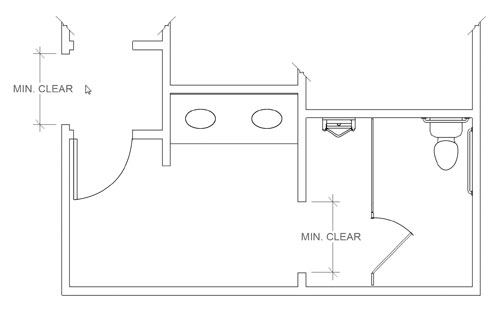A Practical Guide to 2010 ADA-Compliant Restroom Design
The 2010 ADA Standard mandates that specific clear width dimensions must be maintained throughout an accessible route so that a person with a disability can move freely through the space, without being required to weave around a room full of obstacles. Specifically the code identifies the clear width of the accessible route shall be 36 inches minimum and also requires that door openings provide a clear width of 32 inches minimum. Openings more than 24 inches deep shall provide a clear opening of 36 inches minimum.
 |
|
Image courtesy of The ASI Group adapted from the 2010 ADA Standard Stipulate “minimum clear” on the drawing to safeguard important clear width dimensions. |
The most common places where clear width compliance issues are found are at vestibule entry points and at passageways through the walls. The problem often arises from a simple measuring mistake. Clear openings with swinging doors, for example, must be measured between the face of the door and the stop, where the door is open 90 degrees. One way to avoid an issue in these areas is to identify these clear width dimensions on the drawings where they occur. Designers can stipulate a “minimum clear” or to “hold this dimension” on the drawing, where necessary.
Provide Clear Floor SpaceAs mentioned previously, clear floor space describes the minimum unobstructed floor or ground space required to accommodate a single, stationary wheelchair and occupant. The 2010 ADA Standard requires a 30-inch by 48-inch clear space minimum at every fixture, accessory and operable piece of hardware in a restroom, with the exception of the water closet which now requires a larger clear floor space. This requirement ensures that a person in a wheelchair can roll up to the fixture or accessory, such as a toilet cover dispenser, with either a forward or parallel approach, and use it appropriately.
The sheer number of fixtures and accessories typically found in a restroom can make it challenging for a designer to carve out enough clear floor space to be compliant. In fact, not providing enough clear floor space to accommodate a wheelchair at every accessory is one of the most common ADA violations seen in restrooms. Unfortunately, creating acceptable clear floor space is slightly more involved than simply drawing a 30-inch by 48-inch rectangle under each fixture or accessory on the floorplan. Clear floor space for a sink can include the space underneath the sink all the way to the wall, if there is appropriate clearance for a wheelchair and occupant to fit underneath the sink. Clear floor space for accessories and sinks must adjoin the accessible route or path of travel through the restroom. And, generally speaking, door swings may not impinge on clear floor space.
Turning Space RequiredThere are only three room types that are required by the ADA to offer adequate turning space. They are dressing rooms, hospital patient rooms and restrooms. In the restroom, turning circles are only required in the main toilet room, not in the accessible stall, and designers may use either a turning circle or T-shaped space to meet the requirement.
In the 2010 ADA Standard, section 304.3.1, the turning circle is defined as a space of 60 inches in diameter minimum that also includes knee and toe clearance in compliance with section 306. Section 306 defines acceptable knee and toe clearance as the vertical space between 9 inches and 27 inches AFF with a minimum depth requirement of 11 inches deep at 9 inches AFF for toes and 8 inches deep at 27 inches AFF for knees.
The parameters of the T-shaped turning space are a 60-inch-square minimum with arms and base that are a minimum of 36 inches wide. Each arm of the T shall be clear of obstructions 12 inches minimum in each direction and the base shall be clear of obstructions for 24 inches minimum. The T-shaped turning space will also include knee and toe clearance complying with 306, identical to the turning circle requirements, but are only required at the end of either the base or one arm.
Turning space and the required clear floor space for fixtures and accessories are allowed to overlap. When the requisite turning space must occur underneath another restroom fixture or accessory, make certain that the appropriate under-counter clearance for knees is provided.
Clear Door SwingsThe 2010 ADA Standard specifies a number of conditions to ensure that individuals with disabilities can enter and exit the restroom without excessive hardship and can occupy a restroom space without being forced to constantly maneuver around an opening and closing door. To that end, in typical restroom applications, doors are not allowed to swing into the clear floor space that belongs to any fixture or accessory; however they are permitted to swing into established turning areas.
As part of the accessible route, restroom doors shall provide a minimum clear width of 32 inches and there must be enough clear floor space on either side of the door to accommodate the door swing and maintain the minimum clear width of 36 inches along the path of travel. Safeguard compliance in these problematic areas by indicating the clear width dimensions on the drawings and being cognizant of the fact that dimensional errors and even the depth of the finish on the door can erode the requisite clear width minimums.









